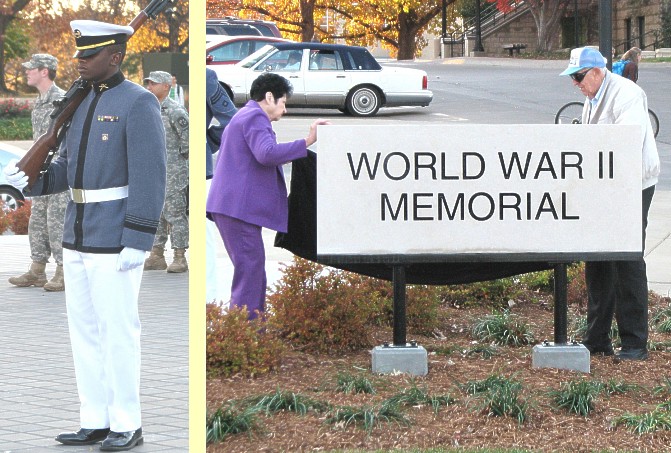Kansas Snapshots by Gloria Freeland - Nov. 19, 2010
"Tags of Honor"
Speakers were going over their notes and making sure the black cloths were properly draped. Everyone was talking, laughing and greeting acquaintances, except for the young man
in uniform. He was standing at attention, eyes looking straight ahead, ignoring all the activity around him. Sprinkled throughout the crowd, I noticed several veterans, some widows
of veterans, and Reserve Officer Training Corps - ROTC - cadets.
It was Nov. 10 - one day before Veterans Day - and the event was the unveiling ceremony at Kansas State University's World War II Memorial.
Veterans and their family members and friends were there in October 2008 too, watching the ground-breaking ceremony - except this year there weren't quite as many. Two years ago, Army and
Air Force cadets brought soil gathered from every veterans cemetery in Kansas, Arlington National Cemetery, some smaller cemeteries and even
from a few private family plots to become part of the memorial's foundation.
Afterward, workers started construction of the memorial. First trees needed to be removed. Then the ground was prepared and concrete was poured. Finally, limestone blocks
were brought in to form the circular walls.
The memorial will be seen daily by many people on campus, located as it is just southeast of Anderson Hall, the university's main administration building, and just to the north of
McCain Auditorium. I've passed it almost every day over the past two years, often struck by its simple beauty as I walk by on my way to and from my parking place and office.
But I doubt many others knew of its significance because there was no plaque, no sign that identified what it was - the long-overdue salute to our World War II veterans. So I was
pleased when I heard last week that the next phase had begun - the unveiling of the artist's plan for the sculpture that will stand in the middle of the memorial.
The sculpture - "Tags of Honor" - was created by Tim Chapman, president and CEO of the Fort Hays State University Foundation and a former employee of the KSU Foundation. It
consists of a large pair of "dog tags" - the soldier's term for the small metal tags worn around his neck when on duty. They contain his name and other essential identifying
information. The tags to be sculpted will be historically accurate for the World War II era and will rest on a pentagonal-shaped base.
Surrounding the tags will be three bronze plaques, designed by Dan Hunt, sculpture professor at K-State. The plaques will represent the military services in the air, on land and on
the sea. Another plaque will explain that the memorial was built upon soil gathered from different cemeteries and private plots.
The artist and others spoke briefly before the sculpture plan was unveiled by World War II veterans Burke Bayer and Cecil Eyestone. Then World War II veteran John Lindholm and
Wanda Jepsen, the widow of World War II veteran Dick Jepsen, removed the black cloth covering the memorial's signpost.
Afterward, several young soldiers performed a ritual changing of the guard - marching into position, shifting their rifles, gloved hands sliding over their weapons - with every move
choreographed as precisely as any dance. The ceremony concluded with the playing of "Taps."
As the others left, I turned to walk back to my office. It seemed hard to believe we had waited 65 years to honor the men and women of the K-State community who served and
sacrificed for their country during World War II. But those who returned after the war were not looking backward, but forward to what they would do next. And the rest of the country? Well, it
wanted to move on too. Recollections and building memorials are for old age when there is little else left to do.
And so, just like our nation at large, we came perilously close to never expressing to them the thanks they deserve.

